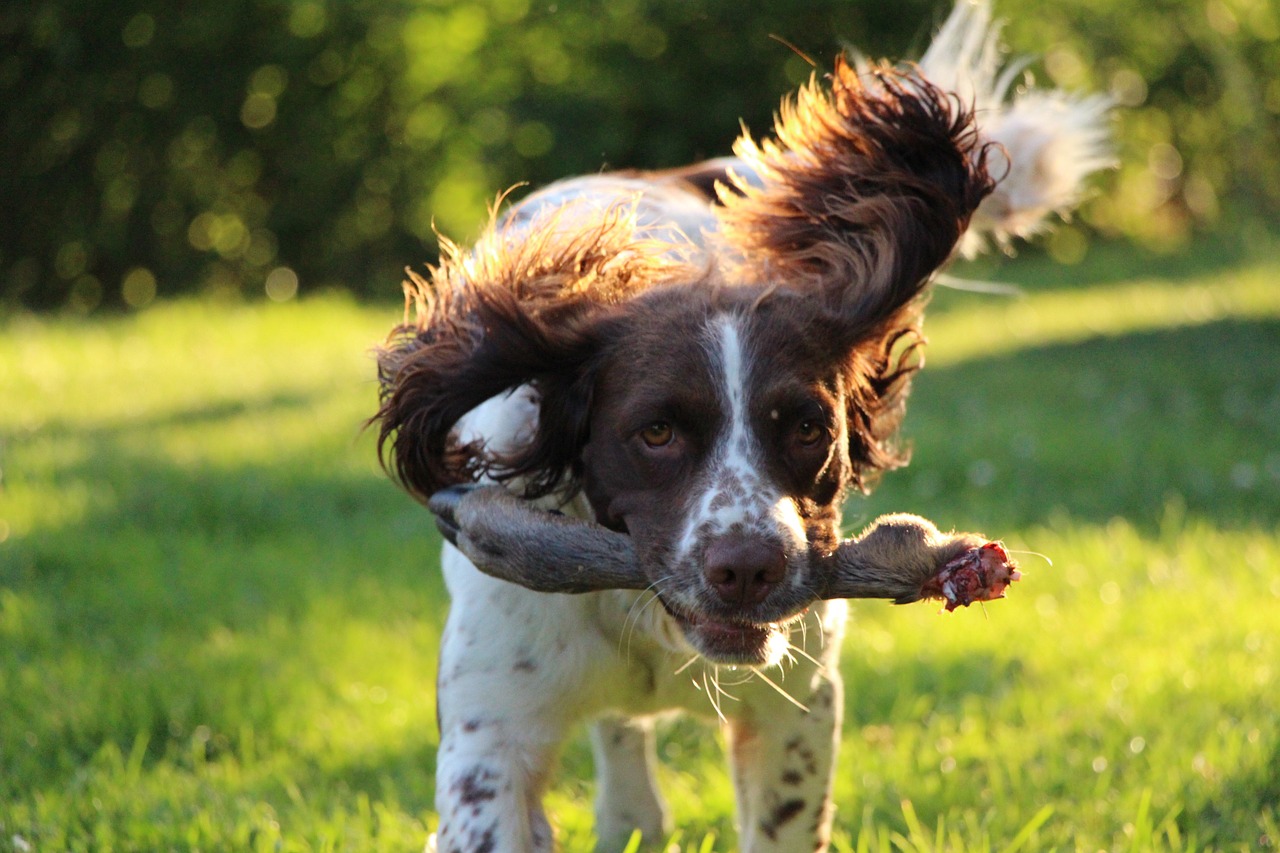As a new owner of a spaniel puppy, it’s important to consider how you will introduce your dog to some basic spaniel training exercises.
Proper training will help your spaniel become a well-behaved adult dog and establish a strong foundation for future training.
In this article, we will discuss some essential aspects of spaniel training, from puppy development to hunting, and provide practical tips on how to train your spaniel to an excellent standard.
A puppy is often too young to begin proper training but there are some basic exercises that you can do with the youngster to encourage him to develop some good habits that will help him to become a well behaved adult dog. By doing these exercise you will set some good foundations for future training.
Spaniel puppy development
Puppies in the same litter develop and mature at different rates and there is also wide levels of variance across the different Spaniel breeds.
Springers tend to mature more quickly than Cocker spaniels for example.
However, it’s essential to take into account your puppy’s temperament and personality when determining the appropriate age to begin training.
A sensitive puppy will require more encouragement than an outgoing and bold one, and may mature more slowly as a result.
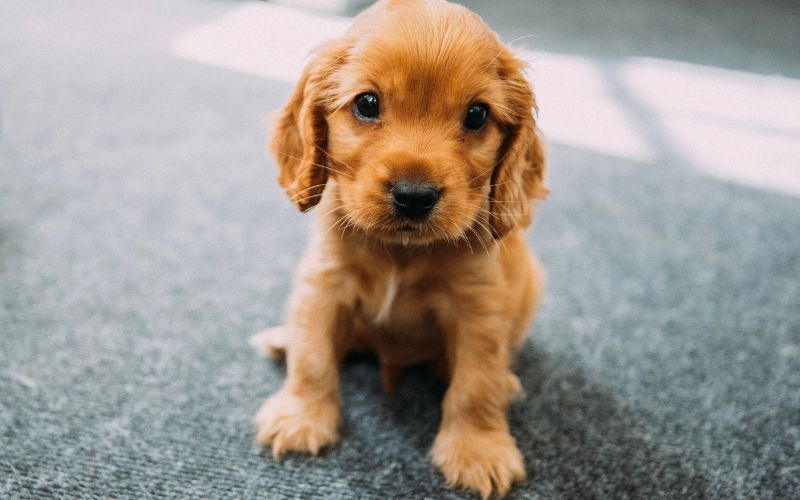
Take your time and don’t rush your dog. Get to know him and don’t be too hasty to rush ahead into more advanced training. Give your puppy the chance to learn and to enjoy spending time with you.
What age should you start training a spaniel puppy?
The general consensus of opinion is that the earliest start time for basic spaniel training is six months old.
However, it’s crucial to consider your puppy’s temperament and character before beginning training.
If you notice a loss of enthusiasm from your pup during training, it’s advisable to take a break and wait until he’s ready to continue.
It won’t do your dog any harm to take a little holiday from training, and often a break can make all the difference, both to the pup and the owner/trainer.
How often should you do training?
When it comes to training your spaniel, the “little and often” approach is far more suitable and effective than “binge” training.
Instead of cramming a lot into a small number of sessions, it’s better to do short, frequent training sessions.
Try to be aware of your dog’s moods and energy levels, as they can have good and bad days and get unwell or tired.
If you adopt a dog-friendly approach and don’t rush, you’ll make better progress. A regimented and unrelenting regime could do more harm than good.
If things aren’t going well, take a break for a few days and take your puppy for a walk instead until he starts wagging his tail again.
Then, you can feel more confident and start again where you left off.
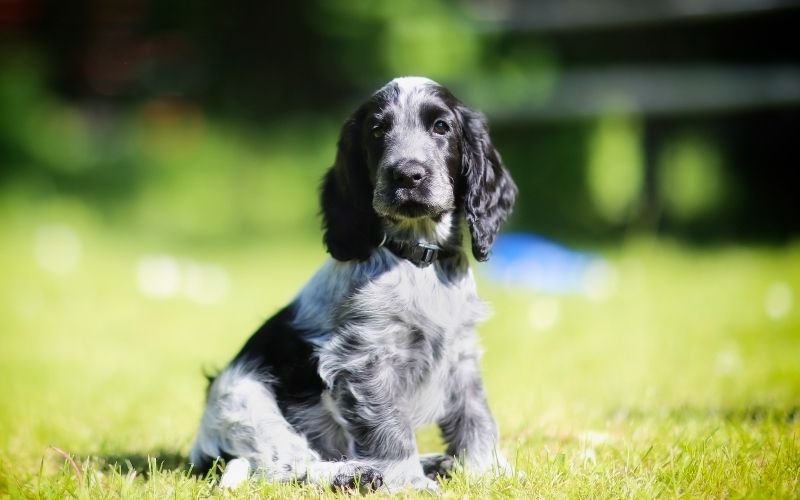
Dog training ground
If you have a big garden or yard or somewhere that you can use such as a field then that will be ideal for basic spaniel training.
Make sure that there is no risk of distraction from game or other dogs or wildlife, then you can use this area to teach most, if not all, of the basic spaniel training activities.
As long as your puppy is happy and lively he should enjoy the training and it’s unlikely that you’ll have any problems.
The most important rule when training a spaniel puppy is you, the puppy and solitude.
Avoid distractions, such as children, other dogs, your family and don’t demonstrate your puppy’s ability to people.
Get his undivided attention and you’ll do well and make good progress.
Improve your knowledge by reading about spaniel training
[amazon box=”1853104191″ template=”horizontal” description=”Our recommended choice for a spaniel training book”]
Beginning the puppy training
Take your puppy to your training area on his lead and let him run around for a few minutes, call him to you, make a fuss of him, let him have a retrieve of a small dummy.
Create a happy positive atmosphere for the puppy and keep him interested in the things that you are doing.
Sitting at a distance
About this exercise
Teaching your spaniel to sit at a distance is a crucial aspect of basic spaniel training, as it allows you to control your dog when he is away from you.
This exercise builds on the basic task of sitting down to the raised hand and “hup” command when you give the puppy his meals and is a natural progression in his training.
After a few minutes of letting your puppy run around, call him to you, make a fuss of him, and let him retrieve a small dummy.
Create a happy, positive atmosphere for the puppy and keep him interested in the things that you’re doing.
Introducing Sitting at a Distance
To introduce sitting at a distance, call your puppy to you and make him sit in front of you with your voice command and hand signal.
Keep your hand up, repeat the command, and take two steps backward. Hesitate for a second, then step forward to your original position, bend down, and give him lots of exaggerated praise.
This is a simple exercise that can be achieved within a short amount of time, and most dogs will quickly “cotton on” if you have been diligent at mealtimes with the “hup” command.
However, if you have a sensitive puppy, he can be easily frightened, so proceed carefully and slowly with patience and perseverance.
Don’t run back to him if he gets up – this will have the same frightening effect on him. If you try and the puppy won’t have it, then forget the exercise for that day.
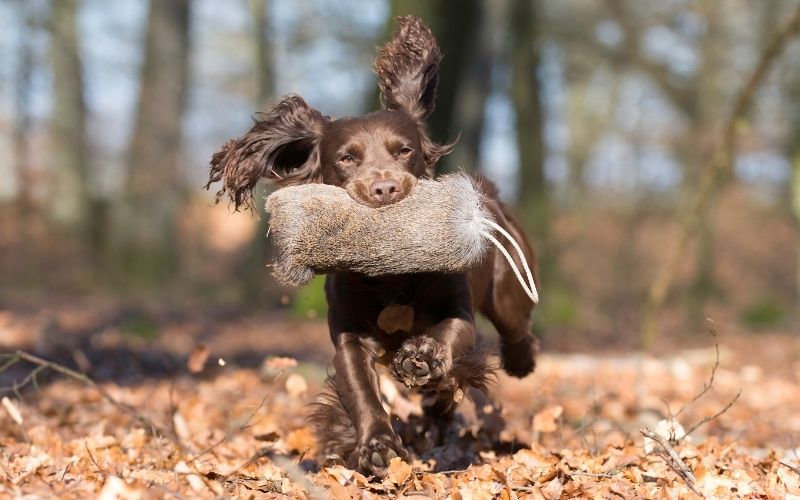
Daily training practice
Each day you should incorporate this lesson into your training, building on it and gradually increasing the amount of steps that you take backwards until you can get to twenty steps.
You then pause, and then return without him fidgeting or getting up or ‘belly crawling’ towards you.
If, during this exercise he does attempt to come towards you ( and most dogs will at some point do this ) then you should quickly reinforce your command with a louder, more gruff, disapproving tone while at the same time taking one or two steps towards him.
Often this is enough to get the puppy to sit back down.
As soon as this happens take two short steps back, a quick pause, then walk forwards to him and reward him with exaggerated praise.
Your objective is to show the dog what you want him to do by repeating the exercise over and over.
Patience when training is vital
You must never frighten your spaniel by losing your temper or smacking him, he is only a puppy with a still developing brain.
Be calm, cool and collected. By all means be firm.
Calmness wins the day every day when spaniel training and you will experience better, faster results if you keep your cool.
Remember that you are the human and he is the dog.
If it goes wrong then it’s normally your fault. Take a deep breath and think it through calmly.
There are also some breeds of spaniels such as the Sussex spaniel, that can be stubborn on a bad day.
If this happens, end the training session with a positive and go home and put the kettle on.
Pick things up a day or two later.
Once you are able to walk back twenty paces and return to the puppy without him getting up, then you are ready to move onto the next stage which is a natural progression.
Please make sure that your puppy is ready to do this as you’ll potentially undo your hard work if he isn’t.
Next steps in puppy training
Your basic spaniel training will continue along the following lines:
Get your puppy to sit as before but, instead of walking away from him and then returning, you call him up with the whistle.
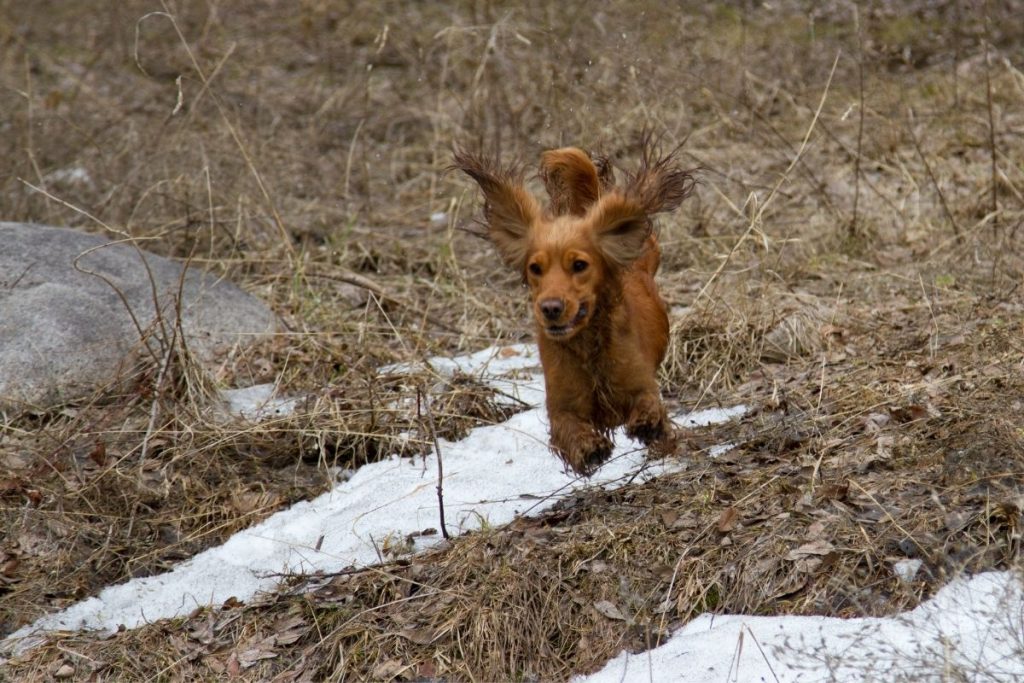
The first time that you do this there is a good chance that the puppy will hesitate.
This is a good sign that out sitting at a distance training has been successful, the puppy doesn’t believe that you want him to come to you.
Therefore you’ll need to encourage him the first few times that you try this.
Be aware that when you do this you are ‘weakening’ the previous exercise that you’ve been teaching for a few weeks, so play safe and keep the puppy guessing by only calling him to you once out of every three or four times that you leave him sat down.
Do this exercise as part of the puppy’s daily routine, don’t be like a sergeant major but keep the puppy interested and happy by playing and making a game of it.
This may seem like a boring lesson but it is really important that you can control your dog at a distance and that your spaniel puppy gets this right before moving onto more advanced training.
Hunting
The most important activity for any working spaniel, and the most enjoyable for all spaniel breeds, is hunting.
When your spaniel is a young dog you should explore lots of different areas with him where he can sniff around and explore but you need to try and control when he does this so that it does not adversely affect his training.
The best time to let him have a run, hunting, is after you have done your basic training for the day when he has completed the daily exercises of retrieving, sitting and staying.
Hunting is such a powerful drive for spaniels and can be an overwhelming force for many of them and a spaniel that has been allowed to do lots of hunting when he is young will often be distracted by the sheer enjoyment of it, to such an extent that the rest of his training suffers.
So let him hunt when he is young, but always in moderation and always at the end of a training session as a reward for ‘good work’‘.
Final Words
Basic spaniel training exercises are important for your young spaniel, as they lay the groundwork for future training and help to ensure that your spaniel becomes a well-behaved and obedient adult dog.
It’s important to remember that every puppy is different, and training progress can vary depending on the breed and individual temperament.
Therefore, it’s essential to be patient and consistent with your training and to adapt your approach to suit your dog’s needs.
Remember to train your spaniel little and often, and to keep training sessions short and enjoyable for your dog.
Always be positive and patient with your dog, and never resort to punishment or aggression.
Use plenty of praise, treats, and toys to reward good behaviour and make training a positive experience for your spaniel.
Finally, it’s important to understand that basic spaniel training is just the beginning.
As your spaniel grows and develops, you can progress to more advanced training exercises, such as retrieving game, flushing out birds, and working in the field.
With patience, consistency, and lots of positive reinforcement, you can help your spaniel become a highly skilled working dog and a loyal companion for life.

